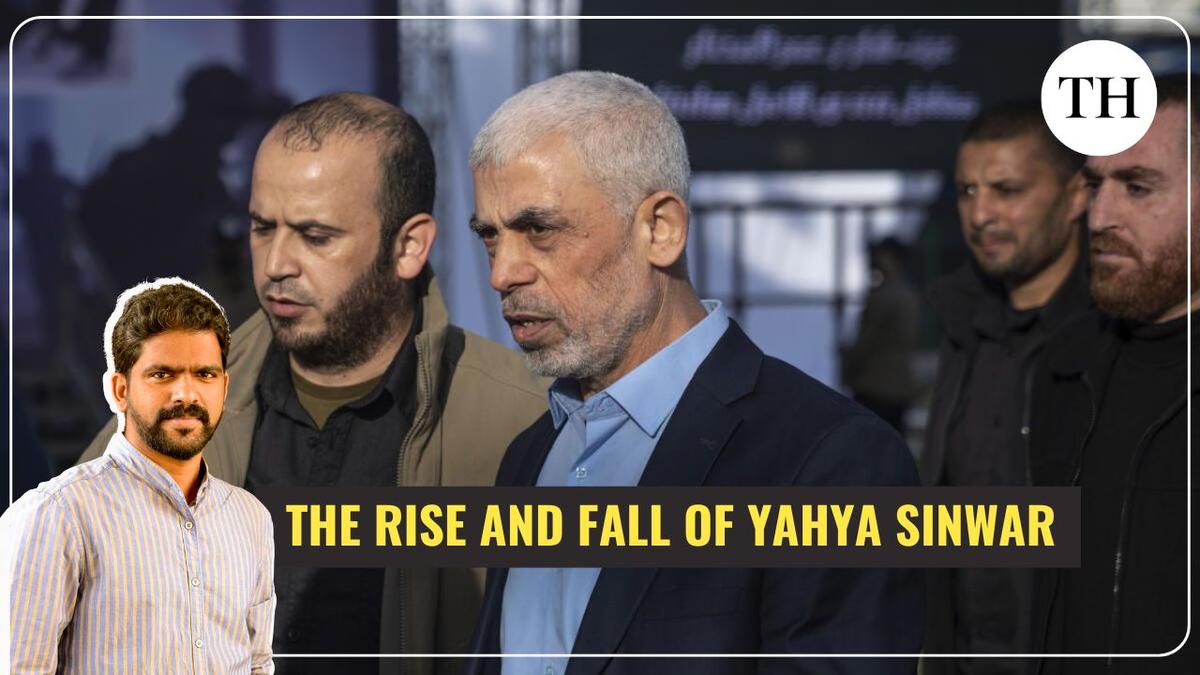After Hamas’s October 7, 2023 attack in Israel, in which about 1,200 people were killed, the Israeli Defence Forces (IDF) called Yahya Sinwar, the leader of the Islamist militant group in Gaza and a key architect of the attack. “a dead man walking”. On October 17, 2024, a year after the war in which over 42,000 Palestinians, a vast majority of them women and children, were killed, the IDF announced that it killed its most wanted man in an operation in Gaza’s Rafah. For over a year, Sinwar was Israel’s most wanted man. With him dead, Israel has taken a major tactical victory and dealt a heavy blow to Hamas.

How did Sinwar, who was born in a refugee camp in Khan Younis in southern Gaza in 1962, become Israel’s most powerful enemy? His story was intertwined with that of many Palestinians in Gaza, who grew up under occupation and turned to radicalism and militancy for resistance and perished in wars, after spilling the blood of many.
Sinwar grew up under foreign occupation–first Egyptian and then Israeli. His parents were from Al-Majdal, a town north of Gaza which is today known as Ashkelon in Israel proper. His parents were forced out of their homes in 1948, when the state of Israel was created. Some 7,00,000 Palestinians were made refugees between 1948 and 1949, in what they call Nakba (catastrophe). The Sinwars fled south towards Gaza, and settled in Khan Yunus.
Sinwar became active in the Muslim Brotherhood in the 1980s and was first arrested by Israel in 1982, when he was 19 years old. When Hamas was founded in 1987, Sinwar established the group’s internal security organisation, al-Majd, which was accused of targeting several Palestinians “for collaborating” with Israel. Sinwar was a brutal enforcer of loyalty. In 1988, he was arrested by the Israelis, convicted for the murder of 12 Palestinians and sentenced for four life sentences. He spent 22 years in Israeli prisons. But prison never broke him. He once told a Shin Bet interrogator, “You know that one day you will be the one under interrogation, and I will stand here as the government, as the interrogator.” That day never came.
A fluent Hebrew speaker, Sinwar was driven by his deep antipathy towards the Israeli occupation of Palestinian territories and deep commitment to the Islamist ideology of Hamas. The Israeli prison for him was a learning “academy”. He said he was “married to the Palestinian cause”. And violence defined his method, right from the days when he was hunting down the “collaborators” in Gaza.
He was released in 2011 as part of a prisoner swap deal when Israel freed 1,027 Palestinian prisoners in exchange for one soldier, Gilad Shalit, who had been taken captive by Hamas in 2006. By that time, Hamas was already in power in Gaza, and Ismail Haniyeh was its leader. As a former internal security chief who spent two decades in Israeli prisons, Sinwar already enjoyed a cult status among Hamas’s top ranks. He rose quickly within the militant group, and established close links with Haniyeh, and Hamas’s foreign backers, including Hezbollah and Iran.
In 2017, when Haniyeh became the head of Hamas’s Polit Bureau, Sinwar was chosen as the group’s leader in Gaza. A year later, in an interview, Sinwar said his life as the administrator of Gaza, which had been under Israeli blockade since 2007, was not any different from the time he spent in Israeli jails.
But in the following years, Sinwar would see the Palestinian issue being pushed to a corner of West Asia. There were no talks between the Palestinians and the Israelis. Hamas controlled the blockaded Gaza, while Israel continued to deepen its occupation of the West Bank. The settler political class in Israel started pushing for the annexation of the West Bank settlements. Four Arab countries, including the UAE, would normalise ties with Israel in 2020 in an agreement brokered by the U.S. Saudi Arabia, the custodian of Islam’s two holiest mosques, was in an advanced stage of recognising the state of Israel. Hamas and its cause were being sidelined in a changing region.
Sinwar’s response to those changes was to launch a murderous attack inside Israel. The attack was an immediate success from his point of view — his forces took the Israelis by surprise. The famed Israeli intelligence agencies failed to foresee Sinwar’s move. Hamas militants unleashed violence for hours in Israeli towns. The political leadership was stunned. But Sinwar perhaps miscalculated the Israeli response. He and millions of Palestinians had to pay a heavy price in the following months.
A vast majority of the victims of Hamas’s attack were Israeli civilians, which shook the country. The brutality of the attack further isolated Hamas, while Israel consolidated support among its allies, including the U.S. Prime Minister Benjamin Netanyahu, on whose watch the attack unfolded, launched a vengeful war on the Palestinians in Gaza, destroying much of the enclave. Israel repeatedly resisted calls for a ceasefire, even amid high civilian casualties in Gaza.
Over the past year, it killed several of its enemies. Mohammed Deif, Hamas’s military wing chief, was killed on July 13. Ismail lHaniyeh was killed on July 31 in Tehran. Hassan Nasrallah, the leader of Hezbollah, was killed in a Beirut bombing on September 27. And now, Sinwar was also killed. These are tactical victories for Israel. But what is to be seen is whether these killings would provide Israel with the long-term security it is pursuing or whether the wounds of the wars Israel is fighting would continue to trap the Jewish state in cycles of violence.
Credits
Presentation: Stanly Johny Camera: Thamodharan B Production: V Nivedita
Published – October 18, 2024 11:05 pm IST
